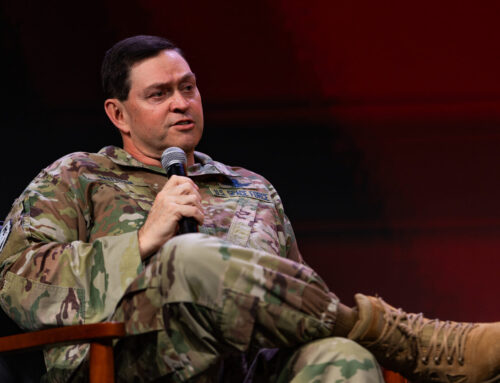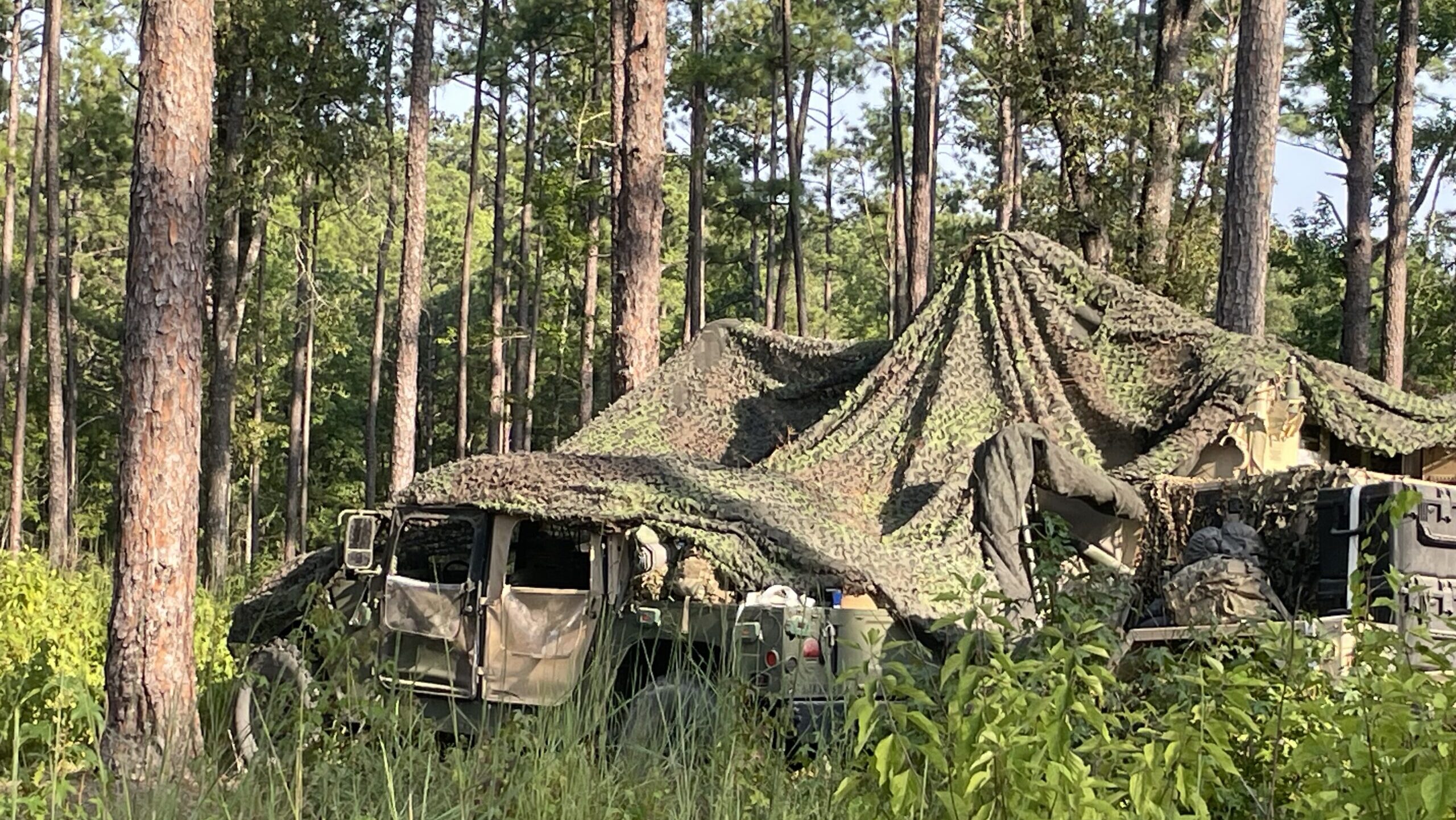U.S. Army Paratroopers of the 2nd Brigade Combat Team, 11th Airborne Division stand at the ready to airdrop from a C-17 Globemaster III at Joint Base Elmendorf-Richardson, Alaska, Jan. 30, 2024. (U.S. Air Force photo by Airman 1st Class Johnny Diaz)
WASHINGTON — The new head of US Northern Command and NORAD, Gen. Gregory Guillot, is calling for an increased US military “presence” via exercises along Alaska’s coast to help push back against growing Chinese and Russian military activity in the Arctic.
“The best way for us to counter them is to have presence of our own. So, the execution of exercises [and] patrols, in all domains, is extremely important off all of our coast, primarily focusing right now in the region of Alaska,” Guillot told the Senate Armed Services Committee today.
“And the same thing applies on what we call the ‘two o’clock approach’ off on the northeast, making sure that we have presence there,” he said.
Guillot called for a “strong exercise program, multinational, a lot of partners, showing that we have the resolve to defend that most strategic area.”
Guillot took over the NORTHCOM/NORAD reins from Gen. Glen VanHerck on Feb. 4 and this week provided his first testimony about his command’s posture to both the Senate and House Armed Services Committees.
Guillot said he is worried about China’s military buildup in the Arctic zone — in particular repeating to senators his warning on Monday to their House counterparts that he expects the People’s Liberation Army soon will begin deploying aircraft along US Air Defense Identification Zones where NORAD tracks aircraft headed toward US airspace.
“Fortunately, we haven’t seen Chinese aircraft operate near our … Air Defense Identification Zones yet, but I think that that’s coming as early as this year. That shows an overall concern I have about the growing capability of China not only with the aircraft, but also with ships and even submarines being able to range further from China and closer to to our shores,” Guillot said in his HASC testimony.
In response to questions about PLA presence in the region from Sen. Mark Kelley, D-Ariz., who recently visited US Navy forces in the Arctic, Guillot stressed that he has seen “a willingness and a desire by the Chinese to act up there.”
He elaborated that China is conducting regional maritime activities “under the cloud of a technical or scientific research, but we think it’s certainly multi-mission to include military” operations. “And then I expect to see air activity in the Alaska part of the Arctic as soon as this year potentially. It’s a very big concern of mine.”
Guillot noted that Russia also is stepping up its military forces in the Arctic.
“Just last week, for the first time in over two years, the Russians sent two Bear bombers down along that avenue through what we call the GIUK gap — Greenland, Iceland and the United Kingdom — approaching the Canadian and the United States Air Defense Identification Zones,” he said.
The GIUK gap separates the Norwegian Sea and the North Sea from the Atlantic Ocean, and is considered a naval choke point. NORAD on Feb. 6 issued a press release saying that four Russian aircraft were seen operating inside the Alaskan Air Defense Identification Zone, but did not specify what type.
“We were able to track them the entire time thanks to the radar network and the information sharing between countries within EUCOM [US European Command] — Norway is one I’ll point out — and Northern Command,” Guillot explained.
“We didn’t have to intercept them because we had aircraft flying to the point where we would intercept them before they crossed the identification zone. And the Russians turned around prior to reaching that zone,” he added. “So, we had aircraft, both Canadian and US fighters postured along the line, which I think is probably disheartening to the Russians to fly all that way to find out that that we’re waiting for them.”
Chinese Hypersonics And Russian Icebreakers
Guillot told the SASC that while NORTHCOM/NORAD have increased capabilities to track things, like Chinese surveillance balloons, there is still a “gap” in the ability to keep eyes on hypersonic missiles.
“I view hypersonics as perhaps the most destabilizing threat that we have out there because of the fast speed, and more than that, the maneuverability and the unpredictability on where it will impact — as opposed to a ballistic missile, which is fairly predictable,” he said.
Sen. Deb Fischer, R-Neb., cited House testimony Monday [PDF] by Jeffrey McCormack, a senior official at the National Air and Space Intelligence Center, asserting that China now “has the world’s leading hypersonic arsenal” to press Guillot on whether he believes the Defense Department needs to “accelerate development” of hypersonic defense systems.
“Senator, I support moving all of our capabilities against the strategic threats that you mentioned as far left as possible, based on the growing and consistently growing capabilities of our adversaries,” he answered.
In addition, Guillot said that the US military is woefully outnumbered by the Russian icebreakers in the Arctic.
“We do appreciate that the Coast Guard is procuring more icebreakers, but even with those we’ll be severely outnumbered. And that does limit our freedom of maneuver in that region,” he said.
Guillot’s testimony comes as the Pentagon gets ready to release an updated version of its Arctic Strategy, last issued in 2019. That strategy could be out as soon as the end of next month, according to a March 12 report in Defense News. That report quoted Iris Ferguson, deputy assistant secretary for Arctic and Global Resilience, as saying that the new strategy for the first time will lay out individual service acquisition requirements to meet the new challenges.
A RAND report issued in November said that the services have a host of urgent needs, including “assets with proximity to support response; multidomain awareness and communications; infrastructure for response and logistics; sufficient cadre of personnel trained, current, and proficient with the skills to operate in this harsh environment; tactics and equipment for low-probability, high-impact incidents; and the ability to scale presence.”
Meanwhile, Guillot told the HASC on Monday that he is conducting his own review of NORTHCOM/NORAD needs to address growing adversary challenges to the US homeland.
“Upon taking command, I began a 90-day assessment to inform the department, the Joint Force and Congress on NORAD and NORTHCOM’s ability to execute assigned tasks, and make recommendations on where the command could or should do more,” he said. “Once complete, I look forward to sharing my findings and updated vision for how NORAD and NORTHCOM will best execute the noble mission of homeland defense.”











